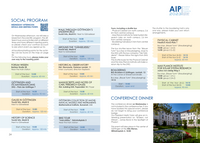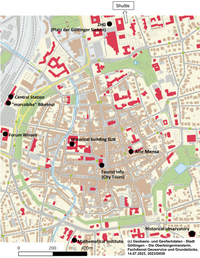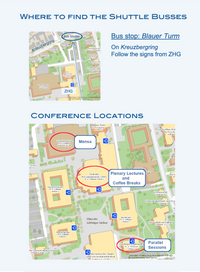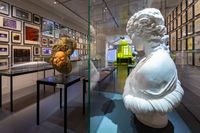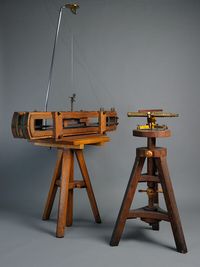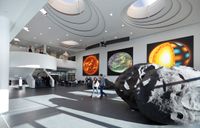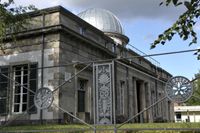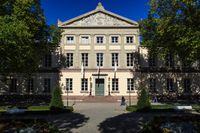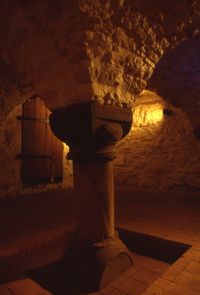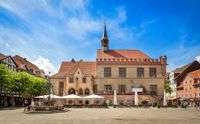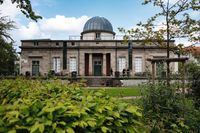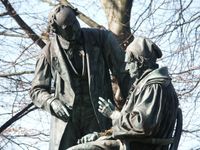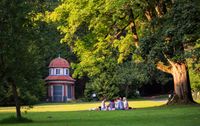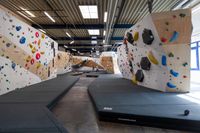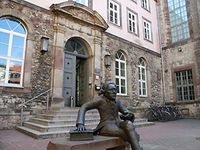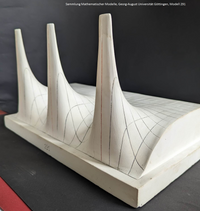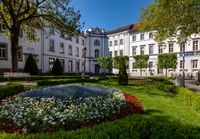Overview of the social program
Please see the table below to find the times, meeting points and locations. Scroll down for detailed tour descriptions.
Find the locations/starting points on this map:
Sunday, 03 September 2023
Ice breaker
18:00 – 21:00, ZHG (Zentrales Hörsaalgebäude), Platz der Göttinger 7
All participants are welcome for a get-together with drinks and fingerfood to open the conference in a relaxed way. You can also register during this event to have an easy start on Monday morning.
Wednesday, 06 September 2023
Social events
14:00 - 17:30, various locations
On Wednesday afternoon, we will take a break from the scientific program. We propose several social activities which are described below. You can make your choice during the registration process (in conftool).
All guided tours will be in English and last between 60 to 90 minutes, except for the bike tour (120 minutes).
Forum Wissen: Göttingen´s academic museum
Guided tour through the core exhibition “spaces of knowledge”
The core exhibition is the very heart of Forum Wissen. On two floors, it extends over an area of 1,400 m². It takes visitors on a journey through three “Prologue Spaces” and 12 “Spaces of Knowledge”. Its central theme is the production of knowledge: How and where is knowledge produced, disseminated and corroborated? Which actors are involved – which people, things or contexts? The majority of the exhibits come from the collections of the University of Göttingen. Based on these local object collections, constellations and narratives, the exhibition presents various general principles of how knowledge is created.
Physical Cabinet
Guided tour through the collection of historical instruments, highlights are exhibits from Gauß, Weber and Lichtenberg
At the entrance to the new lecture halls, one finds the collection of historic instruments. It mirrors, from the beginnings of systematic research in the 18th century to it’s most famous period as world leading center for physics and mathematics in the first half of the 20th century, the history of physics in Göttingen. One can imagine Lichtenberg sitting at his desk making notes, an electrophorus nearby, with its shiny resin cake surface, surrounded by dull leather, misty glass and fragile brass crafted fragile artistically crafted instruments. It is the hands on experience that makes a tour through 250 years to an impressive experience of physics history.
Max Planck Institute for Solar Systems Research
Guided tours at the Max Planck Institute for Solar System Research
The research focus of the Max Planck Institute for Solar System Research (MPS) is on our immediate astronomical neighborhood – the planets and moons of our Solar System, its comets, asteroids and meteorites, as well as the Sun – and on exoplanets and the interiors of distant stars. The institute contributes (and has contributed) to several past, on-going and future space missions such as Rosetta, Solar Orbiter, JUICE and PLATO including their data analysis which often involves the solution of inverse problems. In the tour, participants will be introduced to the institute’s research topics and methods, learn more about some of these space missions and see the laboratories, in which scientific instruments for space missions are developed and built.
Gauß in Göttingen
Guided city tour about Gauß in Göttingen - the great moments of mathematics
The life and research of Carl Friedrich Gauss had its center in Göttingen. He was director of the observatory, professor at the university and did groundbreaking work in the fields of mathematics, astronomy, geodesy and physics. His greatest invention is commemorated by the Gauss-Weber monument on the Wall: the electromagnetic telegraph.
Although he received several calls to other universities, he lived at the Göttingen Observatory until his death. Gauss' grave is located in the Albani cemetery.
History of science in Göttingen
A guided tour through the history of science in Göttingen: ingenious discoveries, technical revolutions and Nobel Prizes
Freedom of censorship and religion and a well-stocked, easily accessible library attracted many bright minds to the Georg August University of Göttingen, which was founded in 1734. Göttingen's university history is also a story of scientific tightrope walks, technical revolutions and ethical border crossings.
On this tour, you will learn why a lightning rod is not against the divine order, why a female head is very well suited for mathematics, and what the decipherment of Babylonian cuneiform has to do with the Star Trek universe. You will meet rebels and opportunists, self-doubters and visionaries. And you will find out what happens when three Nobel Prize winners publicly admonish a German chancellor.
Walk through Göttingen´s underworld
Guided city tour to the secrets of old vaulted cellars
Freedom of censorship and religion and a well-stocked, easily accessible library attracted many bright minds to the Georg August University of Göttingen, which was founded in 1734. Göttingen's university history is also a story of scientific tightrope walks, technical revolutions and ethical border crossings.
On this tour, you will learn why a lightning rod is not against the divine order, why a female head is very well suited for mathematics, and what the decipherment of Babylonian cuneiform has to do with the Star Trek universe. You will meet rebels and opportunists, self-doubters and visionaries. And you will find out what happens when three Nobel Prize winners publicly admonish a German chancellor.
Around the “Gänseliesel”
City tour to the most important sights in Göttingen
If you want to discover Göttingen and see as much as possible, the city tour "Around the Gänseliesel" is for you. This tour takes you right through the old town and provides exciting and concise information about the most important sights in Göttingen, which should not be missed during a visit to the university town.
From the famous Gänseliesel and the medieval Old Town Hall to half-timbered houses and historic university buildings and churches: The guided tour offers an overview of the special features as well as the cultural and historical highlights of the city center.
The historical observatory
Guided tour of the observatory where Gauß worked and lived
The first director of the observatory was the famous mathematician, astronomer and physicist Carl Friedrich Gauss. For almost 50 years, the building was the home and workplace of the famous scholar, who received a call to Göttingen University in 1807. After completion of the observatory (1816), he lived and researched here until his death on February 23, 1855. The building, which is unique in the history of science, was restored according to historical models.
Göttingen and its mathematicians
Guided city tour with lots of history about the great mathematicians
On a walk through the city learn more about some famous mathematicians and physicists who lived and worked in Göttingen such as Carl-Friedrich Gauß, Gustav-Lejeune Dirichlet, Bernhard Riemann, Felix Klein, David Hilbert, Herrmann Minkowski, Eugene Wigner, Richard Courant, Carl Runge, Emmy Noether, Herrmann Weyl, John v. Neumann, Max Born, Edmund Landau, Alfred Clebsch, and Hugo Steinhaus. The tours will be led by Prof. Robert Schaback and Prof. Gert Lube.
Bike tour
Explore the city by bike or take a guided tour
On this afternoon, our conference participants can rent bicycles for free (limited number only, max. 4 hours) at the Göttingen train station and explore the surrounding area. Bicycle helmets are available for a fee. You can either join groups privately or participate in our guided tour along the Leine (river through Göttingen), approx. 2 hours.
Bouldering
Indoor climbing at the BiG
If you are looking for a balance to the mental work this week, bouldering might be the right thing for you. Whether you are new to bouldering or have some experience, you can spend some time at the BiG in Göttingen. A trainer will be there to help you, rental shoes are included.
We have organized a shuttle to the bouldering hall. Unfortunately, the shuttle only goes one way. Please make your own return arrangements.
You can either walk back to the city center, which takes about 35 minutes (3 km), or you can take the bus. GöVB bus line 110 from Wilhelm-Lambrecht-Straße stop will take you back to the train station.
For public transport tickets, we recommend the Fairtiq app, which allows you to pay easily and cashless after registration.
Manuscripts and notes of Carl Friedrich Gauss
Presentation of selected handwritten notes
The University Library houses the mathematical archive of Carl Friedrich Gauss. Through a small selection of most important handwritten manuscripts and notes, conference participants will have the opportunity to gain an impression of both Gauss's mathematical genius and his everyday personal affairs. The presentation in the archive will be given by Dr. Katharina Habermann (mathematician and subject librarian).
Göttingen Collection of Mathematical Models and Instruments
Guided tour through the collection
The collection of mathematical models and instruments contains more than 500 objects, dating from 1780 to present, with most of them from the 1870-1915 period. It contains mathematical models made of plaster (e.g. Clebsch diagonal surface with 27 real lines), wood, card board, thread, metal, stone; mathematical instruments, spinnung tops, calculating machines,....
Evening talk with dinner
18:00 – 22:00, Alte Mensa
Join us for a conference dinner and enjoy the evening lecture "Shaken, not Stirred! – James Bond in the Spotlight of Physics" by Prof. Dr. Metin Tolan (President of the University of Göttingen)
